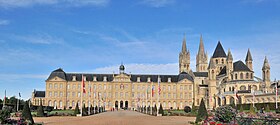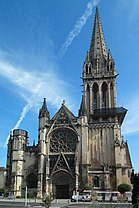
Back Caen Afrikaans ካየን Amharic Caen AN Caðum ANG كان (نورماندي) Arabic كاين ARZ Caen AST Caen Aymara کان (فرانسه) AZB Кан Byelorussian
Caen
Kaem (Norman) | |
|---|---|
Prefecture and commune | |
View of the Hôtel de Ville (left) and the Abbaye aux Hommes (right); The Abbaye aux Dames; Saint-Pierre Church; Rue Froide in the old town | |
| Coordinates: 49°10′53″N 00°21′49″W / 49.18139°N 0.36361°W | |
| Country | France |
| Region | Normandy |
| Department | Calvados |
| Arrondissement | Caen |
| Canton | Caen-1, 2, 3, 4 and 5 |
| Intercommunality | Caen la Mer |
| Government | |
| • Mayor (2024–2026) | Aristide Olivier[1] (LR) |
| Area 1 | 25.70 km2 (9.92 sq mi) |
| • Urban | 173.6 km2 (67.0 sq mi) |
| • Metro | 2,597 km2 (1,003 sq mi) |
| Population (2021)[2] | 108,200 |
| • Density | 4,200/km2 (11,000/sq mi) |
| • Urban (2018[3]) | 205,708 |
| • Urban density | 1,200/km2 (3,100/sq mi) |
| • Metro (2018[3]) | 469,526 |
| • Metro density | 180/km2 (470/sq mi) |
| Demonym | Caennais |
| Time zone | UTC+01:00 (CET) |
| • Summer (DST) | UTC+02:00 (CEST) |
| INSEE/Postal code | 14118 /14000 |
| Elevation | 2–73 m (6.6–239.5 ft) (avg. 8 m or 26 ft) |
| Website | caen.fr |
| 1 French Land Register data, which excludes lakes, ponds, glaciers > 1 km2 (0.386 sq mi or 247 acres) and river estuaries. | |
Caen (UK: /ˈkɒ̃ ˈkɒn/; French: [kɑ̃] ; Norman: Kaem) is a commune 15 km (9.3 mi) inland from the northwestern coast of France. It is the prefecture of the department of Calvados. The city proper has 105,512 inhabitants (as of 2018[update]), while its functional urban area has 470,000,[3] making Caen the second largest urban area in Normandy and the 19th largest in France.[4] It is also the third largest commune in all of Normandy after Le Havre and Rouen.[5][6]
It is located 200 km (120 mi) northwest of Paris, connected to the South of England by the Caen (Ouistreham) to Portsmouth ferry route through the English Channel. Situated a few miles from the coast, the landing beaches, the bustling resorts of Deauville and Cabourg, as well as Norman Switzerland and the Pays d'Auge, Caen is often considered the archetype of Normandy.
Caen is known for its historical buildings built during the reign of William the Conqueror, who was buried there, and for the Battle for Caen, heavy fighting that took place in and around Caen during the Battle of Normandy in 1944, destroying much of the city. The city has now preserved the memory by erecting a memorial and a museum dedicated to peace, the Mémorial de Caen.
- ^ "Répertoire national des élus: les maires" (in French). data.gouv.fr, Plateforme ouverte des données publiques françaises. 6 June 2023. Archived from the original on 28 June 2020. Retrieved 11 December 2020.
- ^ "Populations légales 2021" (in French). The National Institute of Statistics and Economic Studies. 28 December 2023.
- ^ a b c Comparateur de territoire Archived 20 June 2022 at the Wayback Machine, INSEE, retrieved 20 June 2022.
- ^ INSEE. "France par aire d'attraction des villes - Population municipale 2019 >> Tableau". Archived from the original on 29 January 2018. Retrieved 20 June 2022.
- ^ "La Normandie compte 3 339 131 habitants" (in French). paris-normandie.fr. Archived from the original on 23 March 2018. Retrieved 22 March 2018.
- ^ "Grande Normandie : combien d'habitants dans votre commune ?" (in French). Archived from the original on 8 September 2018. Retrieved 22 March 2018.







